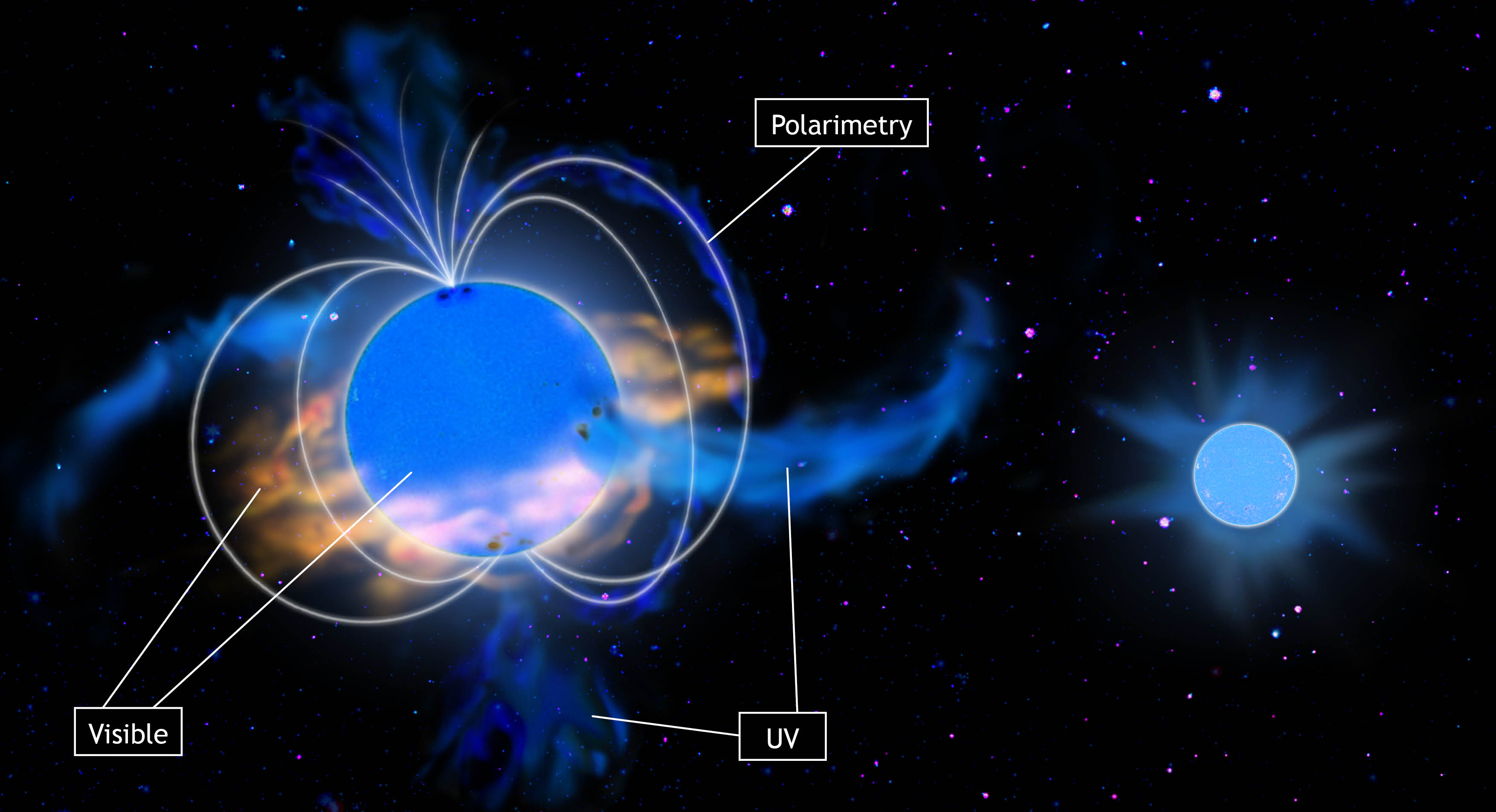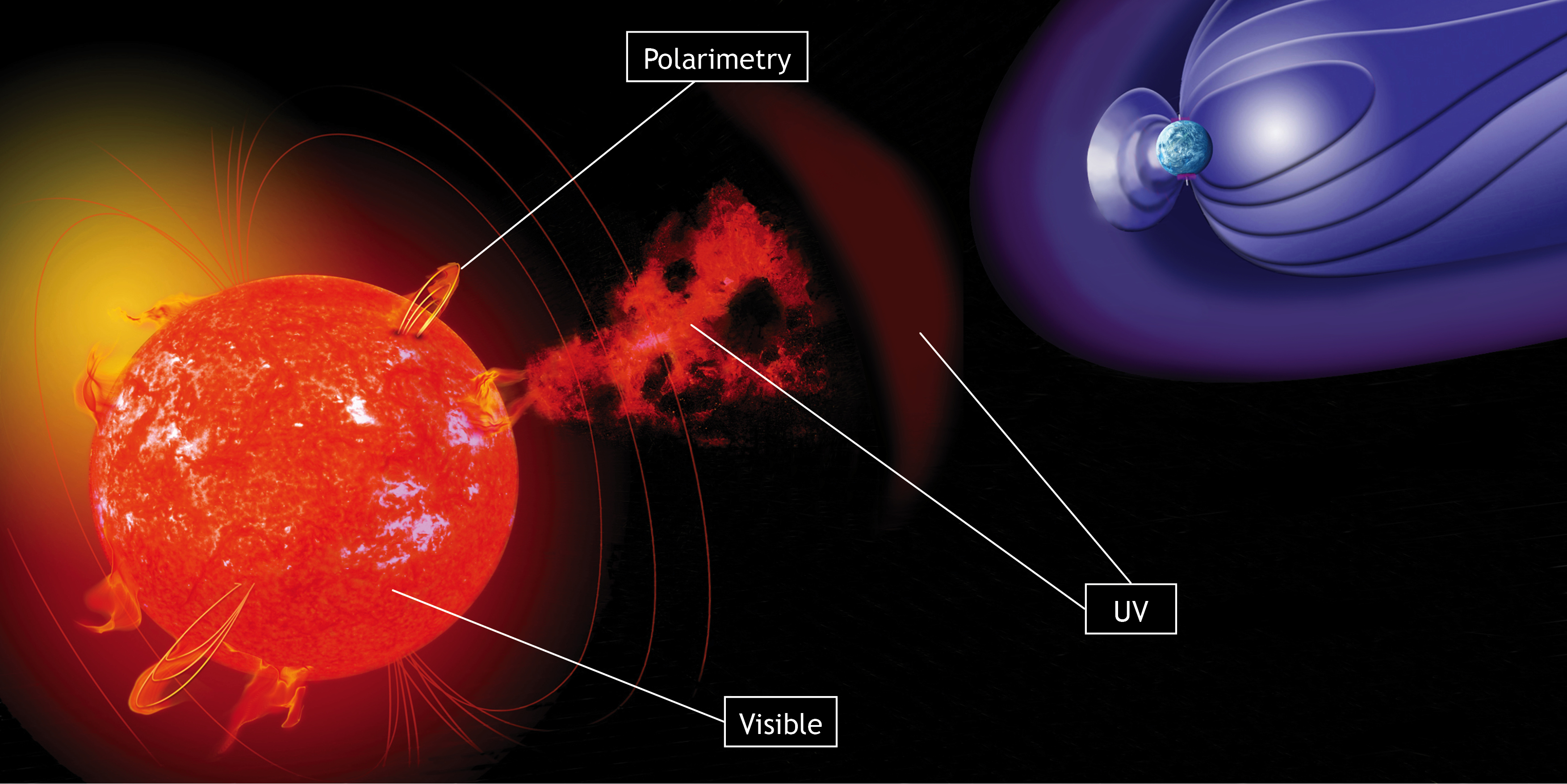Stellar Magnetic Fields across the HR Diagram
We can obtain sophisticated tomographic mapping of structures on the surface of stars and their magnetic fields from current ground-based observations at visible wavelengths.
However, to understand the formation and evolution of stars and their accompanying planets we also need to explore their circumstellar environments. POLLUX offers a powerful,
high-resolution, full Stokes (IQUV) spectropolarimetric capability across the UV domain (90 – 400 nm) to uniquely trace these structures (see Figure). POLLUX will enable
breakthroughs in several areas of contemporary stellar astrophysics.
In the case of young low mass stars, interaction between the stars and their planetary disks are magnetically-mediated during dynamo formation and stabilization, when planets and planetary atmospheres form. As stellar rotation decouples from the young planetary disk, the magnetic-field is predicted to get stronger and more complex (Emeriau-Viard & Brun, 2017). By investigating the propagation of magnetic energy through the stellar atmosphere into the uppermost coronal layers and stellar wind, POLLUX will reveal how the stellar dynamo builds-up and evolves.
How do magnetic fields influence star formation and evolution?
Magnetic fields play a significant role in stellar evolution because they control the angular momentum budget (Townsend 2010) and mediate evolution of accretion processes and wind outflows (ud-Doula et al. 2008); they are also an important factor in both planet and star formation (e.g. McKee & Ostriker, 2007). For stars in the pre-main sequence (PMS) phase, UV spectropolarimetry is the best tool to characterize the strong magnetic fields arising at the sheared interface between the star and the disk (via UV lines like Mg II, Fe II and C II from the interface region), and to trace the flows via polarization measurements of the nearby continuum.In the case of young low mass stars, interaction between the stars and their planetary disks are magnetically-mediated during dynamo formation and stabilization, when planets and planetary atmospheres form. As stellar rotation decouples from the young planetary disk, the magnetic-field is predicted to get stronger and more complex (Emeriau-Viard & Brun, 2017). By investigating the propagation of magnetic energy through the stellar atmosphere into the uppermost coronal layers and stellar wind, POLLUX will reveal how the stellar dynamo builds-up and evolves.
|
Schematic view of the different features and regions traced by observations at different wavelengths around a hot star. Credit: S. Cnudde. |
|
Sketch of a cool star, with its dynamo magnetic field, surface faculaes and plages, wind, a coronal mass ejection, and a bow shock between the star and its planet. Credit: S. Cnudde. |
Stellar magnetism in galactic massive stars, and beyond
A small but significant fraction of massive stars have strong magnetic fields (6-8%; e.g. Fossati et al. 2015b, Grunhut et al. 2017), but ultra-weak fields could be present in the other stars. POLLUX has the unique potential to detect these sub-Gauss magnetic fields in main-sequence massive stars. It will also be able to detect weak fields in hot evolved stars, providing a much needed understanding of the strong field-decay mechanisms and their impact on stellar evolution. Moreover, thanks to the unprecedented collecting power of LUVOIR, POLLUX will extend these studies of stellar magnetic fields beyond the Milky Way (MW) for the first time. This will open up observations in the metal-poor Magellanic Clouds (MCs), probing the evolutionary processes linked to magnetic fields at metallicities equivalent to those at the peak of star-formation in the Universe. This is crucial if we are to understand the progenitors of γ-ray bursts, pair-instability supernovae (SNe), and gravitational-wave sources (e.g. Petit et al. 2017). For that we need to test massive-star models (both for single stars and those in binaries) over a range of metallicity, from the local environs of the MW to metal-poor systems analogous to conditions in the early Universe. One big uncertainty in the latest models is the link between rotation and the mass lost via their intense stellar winds (e.g. Vink & Harries 2017), with a big impact on the ultimate explosions of the stars and the nature of their remnants. POLLUX observations in the Galaxy and MCs across all four Stokes parameters will map the density contrast with stellar latitude to assess the links between mass loss, rotation and environment, providing vital ingredients to calibrate evolutionary models.Outflows & jets
The interaction between disks around PMS stars and their magnetospheres triggers powerful jets that are the earliest tracers of star formation, but the mechanism driving the jets is poorly constrained (von Rekowski et al. 2003, Gomez de Castro & von Rekowski 2011). UV spectropolarimetry with POLLUX of the base of such jets will allow determination of the dominant components of the magnetic-field and their connection with disk rotation and ionization.Extremely metal-poor stars
We can learn about the properties of the first generation of stars formed from primordial, metal- free gas via their chemical imprint on very metal-poor ([Fe/H] < –2.0) stars (Caffau et al. 2011, Keller et al. 2014). Space UV spectroscopy gives access to a vast range of diagnostic elements that cannot be measured from the ground (P, Ge, As, Se, Cd, Te, Lu, Os, Ir, Pt, Au), and enables more robust estimates of species that are otherwise very challenging (Fe, S, Cu, Zn, Pb). As these very metal-poor stars typically have low UV fluxes, the large collecting power of LUVOIR combined with the high resolution and efficiency of POLLUX is needed to probe the nucleosynthesis and early evolution of our Galaxy.Novae & Supernovae
High resolution spectropolarimetry with POLLUX will constrain the dust lifecycle (formation and destruction) in the expanding ejecta in both classical novae and supernovae (SNe) remnants. We will dissect the ejecta structures from their line asymmetries and time variations during dust-forming events, allowing us to infer the effects of kicks imparted by core-collapse SNe, and the sites in the ejecta responsible for dust condensation. POLLUX spectropolarimetry will also tell us about the shapes/sizes of the grains involved, furthering our knowledge of this important channel of dust production.White dwarfs
A few percent of WDs are known to be strongly (>1 MG) magnetic (Ferrario et al. 2015), but little is known of the incidence of weaker fields (Landstreet et al. 2012); UV spectropolarimetry with POLLUX will explore the presence (absence) of these. POLLUX will also provide estimates of the rotation periods for a large sample of WDs for the first time, needed to describe angular momentum transport in evolved stars and the processes responsible for magnetic-field generation, amplification of fossil fields and/or binary merger (Braithwaite & Spruit 2004; Tout et al. 2008).



